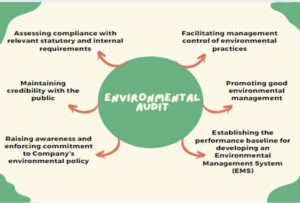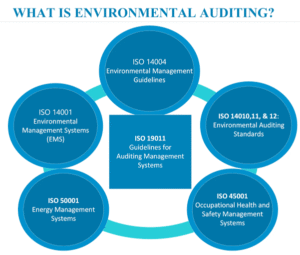Back to: Environmental Biology 500 Level
Welcome to class!
Hello, brilliant scholar! It’s such a delight to have you here again. Your consistency and curiosity show that you’re not just learning for school—you’re preparing to become a responsible guardian of our environment. Today’s lesson is very important in making sure that Environmental Impact Assessment (EIA) isn’t just a document that gets forgotten after approval. We’re talking about Environmental Auditing and Monitoring—two powerful tools that help us protect our environment during and after a project. Let’s walk through this together, in a simple and truly Nigerian way.
Environmental Auditing And Monitoring
What is Environmental Monitoring?
Environmental monitoring is the regular observation, measurement, and recording of environmental conditions during and after a project. It helps us find out if the project is following environmental guidelines and if the environment is being harmed in any way.

Think of it like going for regular health check-ups. After starting a treatment, the doctor monitors your progress to see if the medicine is working or causing problems. Similarly, once a project begins—like road construction, farming, or mining—experts must keep checking air quality, noise levels, water pollution, and more.
Types of Monitoring:
Baseline Monitoring – Done before the project begins (to understand the original condition).
Impact Monitoring – Done during the project to check actual environmental effects.
Compliance Monitoring – Ensures the company is following the approved Environmental Management Plan (EMP).
Post-project Monitoring – Done after the project is completed to track long-term effects.
What is Environmental Auditing?
Environmental auditing is a detailed, independent review to check how well a company or project is following environmental laws, regulations, and policies. It’s like an environmental “inspection” or “accounting” exercise.
While monitoring checks what is happening now, auditing looks back to assess how well the project has performed over time and what improvements can be made.
Why is Environmental Auditing Important?
It helps identify mistakes or bad practices.

It gives organisations a chance to correct issues and do better.
It helps the government and the public hold developers accountable.
It promotes transparency and continuous improvement.
Example:
Let’s say a mining company in Nasarawa was approved after an EIA. Environmental monitoring will measure noise, dust, and water pollution during operations. Later, an environmental audit may discover that the company didn’t build the proper drainage system as promised. That’s a violation—and the audit helps point it out and recommend action.
Roles of Key Actors:
The Project Developer – Must carry out monitoring and submit reports.

Environmental Consultants – Help collect data and interpret results.
The Federal Ministry of Environment & NESREA – Review reports, enforce compliance, and conduct audits.
Community Stakeholders – Report changes or damages they notice on ground.
Summary
- Environmental monitoring tracks changes in environmental conditions during and after a project.
- Environmental auditing is a formal review of how well a project complies with environmental laws and guidelines.
- Both help prevent and correct environmental problems, promoting accountability and sustainability.
Evaluation
- What is the difference between environmental monitoring and environmental auditing?
- List and explain two types of environmental monitoring.
- Why is environmental auditing important in project development?
- Who are the key people or groups involved in monitoring and auditing?
Amazing work today! You’re not just learning—you’re gaining real-world skills that can help shape the future of Nigeria. Environmental monitoring and auditing may not be loud topics, but they are essential in protecting our land, water, and people. Keep going strong—Afrilearn is proud to be on this journey with you. See you in the next class, eco-warrior!
